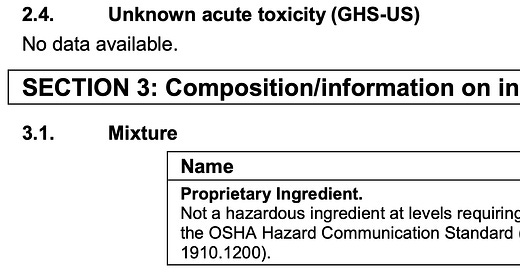Help, Doctor, I've been exposed to [proprietary]!
A diatribe against trade secrets in lab reagents
Exhibit 1: DNA Extraction
Lucigen, a branch of the LGC group, sells a DNA extraction solution that I regularly use in the lab. It works great, but what exactly is it?
As far as I can tell, nobody knows except Lucigen.1 It’s not described in any patents I can find. I took a look at the safety data sheet, which says:
and that’s about it. It claims to be nonhazardous, but I really wouldn’t want to get it in my eye, given its job is to destroy cells for extracting their DNA.
The law governing safety data sheets, 29 CFR § 1910.1200, is written to allow manufacturers to withhold “trade secrets”. So, if I were to be exposed, the doctor treating me would have to call Lucigen, and even then, the doctor probably wouldn’t be allowed to tell me what I was exposed to.
I suspect that the composition is actually quite simple, and it probably costs Lucigen no more than $50 to make the extraction solution they sell for $341. Still, it isn’t worth it for me personally to reverse-engineer the formula, since my lab is well-funded and I have better things to do with my time.
Exhibit 2: Cell culture media
This is far from the only example of trade secrets in lab reagents being toxic. Stemcell Technologies sells several proprietary cell culture media. Our lab regularly uses their mTeSR Plus medium, which is a proprietary variant of the openly2 described mTeSR medium. Stemcell Technologies doesn’t say exactly what changes they made besides stabilizing the FGF2 and having a better pH buffer.
For a few weeks last summer, I was trying to replicate a certain differentiation protocol, from a paper that used mTeSR medium. It wasn’t working; eventually I realized that some difference between mTeSR and mTeSR Plus was the cause. I’m pretty sure it was the stabilized FGF2, since I found that FGF2 had a negative effect. Fortunately, even if Stemcell Technologies discontinues mTeSR, I could still make it myself according to the original formula. The same would not be true of mTeSR Plus, or some of their other proprietary cell culture media.
I’ve also been frustrated by some Japanese papers that use cell culture media that’s only sold by one Japanese company that doesn’t ship to the USA. Is my failure to reproduce their results because their protocol doesn’t work, or because the substitute medium I’m using has different characteristics?
Exhibit 3: qRT-PCR Primers
Some of the worst offenders are companies that sell primers for quantitative RT-PCR, but don’t disclose the sequences. (Origene is one example but not the only one.) It really annoys me to read an paper that used these, and not be able to properly evaluate their results. Or worse, for older papers sometimes the company that sold the primers has gone out of business. There are plenty of tools for designing robust qRT-PCR primers (one good one is Primer-BLAST) so it is frustrating that these companies are still able to sell them.
Exhibit 4: Antibodies
Most companies that sell antibodies for research don’t disclose the exact epitope sequence the antibodies recognize. Some of the better ones will disclose limited information, like “it’s within the first 50 amino acids of the N-terminus”, but others won’t. If I make a modification to my protein, will the antibody still recognize it?
Ideally, everyone would use monoclonal antibodies with the complete protein sequences and epitopes known. I think that’s a pipe dream, though. (This would also solve the problem of wasting money and time on antibodies that don’t work, which is a huge issue in biotech research.)
What is to be done?
All these trade secrets are an endless source of frustration for me, and more broadly, they hurt reproducibility of science.
The patent system exists for a reason: to allow people and companies to profit from their ideas, while at the same time disclosing their best implementations.3 For the good of the research community, companies should use patents instead of trade secrets. Researchers, for their part, should encourage companies to do this by voting with their purchase orders, and also (where practical) by reverse engineering.
Leading by example, here I will reveal the protein sequence of System Bio’s “Super PiggyBac Transposase”, which until now was a trade secret.
MGSSLDDEHILSALLQSDDELVGEDSDSEVSDHVSEDDVQSDTEEAFIDEVHEVQPTSSGSEILDEQNVIEQPGSSLASNRILTLPQRTIRGKNKHCWSTSKSTRRSRVSALNIVRSQRGPTRMCRNIYDPLLCFKLFFTDEIISEIVKWTNAEISLKRRESMTSATFRDTNEDEIYAFFGILVMTAVRKDNHMSTDDLFDRSLSMVYVSVMSRDRFDFLIRCLRMDDKSIRPTLRENDVFTPVRKIWDLFIHQCIQNYTPGAHLTIDEQLLGFRGRCPFRVYIPNKPSKYGIKILMMCDSGTKYMINGMPYLGRGTQTNGVPLGEYYVKELSKPVHGSCRNITCDNWFTSIPLAKNLLQEPYKLTIVGTVRSNKREIPEVLKNSRSRPVGTSMFCFDGPLTLVSYKPKPAKMVYLLSSCDEDASINESTGKPQMVMYYNQTKGGVDTLDQMCSVMTCSRKTNRWPMALLYGMINIACINSFIIYSHNVSSKGEKVQSRKKFMRNLYMSLTSSFMRKRLEAPTLKRYLRDNISNILPKEVPGTSDDSTEEPVMKKRTYCTYCPSKIRRKANASCKKCKKVICREHNIDMCQSCF*System Biosciences sells a plasmid encoding it, with a ccdB toxin so it won’t grow in most E. coli strains. DRM = defective by design. And it doesn’t work in biology.
The two key components are presumably a detergent and a protease. I think the detergent formulation is the most critical, because it needs to be a good enough detergent to break open cell membranes, but not too good that it interferes in downstream reactions such as PCR.
Except for the article paywall, of course.
Unfortunately, the requirement to disclose the best implementation isn’t very strongly enforced, and companies can get away with being rather vague in their patents. This is a separate but related problem.




Really liked this post! So glad to see someone writing about this issue